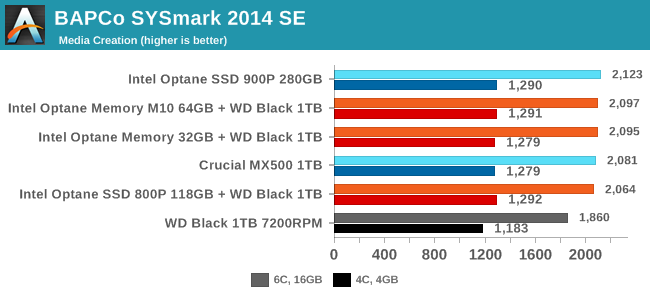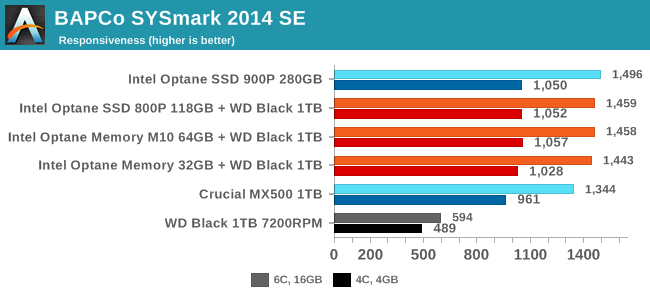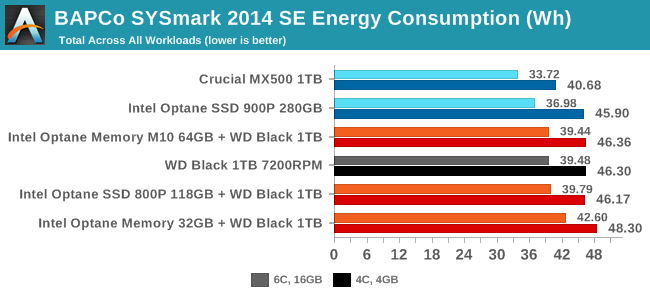The Intel Optane Memory M10 (64GB) Review: Optane Caching Refreshed
by Billy Tallis on May 15, 2018 10:45 AM EST- Posted in
- SSDs
- Storage
- Intel
- PCIe SSD
- SSD Caching
- M.2
- NVMe
- Optane
- Optane Memory
BAPCo SYSmark 2014 SE
BAPCo's SYSmark 2014 SE is an application-based benchmark that uses real-world applications to replay usage patterns of business users in the areas of office productivity, media creation and data/financial analysis. In addition, it also addresses the responsiveness aspect which deals with user experience as related to application and file launches, multi-tasking etc. Scores are calibrated against a reference system that is defined to score 1000 in each of the scenarios. A score of, say, 2000, would imply that the system under test is twice as fast as the reference system.
SYSmark scores are based on total application response time as seen by the user, including not only storage latency but time spent by the processor. This means there's a limit to how much a storage improvement could possibly increase scores, because the SSD is only in use for a small fraction of the total test duration. This is a significant difference from our ATSB tests where only the storage portion of the workload is replicated and disk idle times are cut short to a maximum of 25ms.
For this review, SYSmark has been used on two different machines: a relatively high-end system with a six-core Intel Core i7-8700K processor and 16GB of RAM, and a more limited system with a quad-core Intel Core i5-7400 processor and just 4GB of RAM. The low-end system spends a lot of time swapping thanks to its small amount of RAM, and this adds greatly to the storage workload.
| AnandTech SYSmark SSD Testbed | |
| CPU | Intel Core i7-8700K |
| Motherboard | Gigabyte Aorus H370 Gaming 3 WiFi |
| Chipset | Intel H370 |
| Memory | 2x 8GB Kingston DDR4-2666 |
| Case | In Win C583 |
| Power Supply | Cooler Master G550M |
| OS | Windows 10 64-bit, version 1709 |
| AnandTech SYSmark SSD Low-End Testbed | |
| CPU | Intel Core i5-7400 |
| Motherboard | ASUS PRIME Z270-A |
| Chipset | Intel Z270 |
| Memory | 1x 4GB Corsair DDR4-2666 |
| Case | In Win C583 |
| Power Supply | Cooler Master G550M |
| OS | Windows 10 64-bit, version 1709 |
None of the Optane Memory modules are large enough to serve as a Windows boot drive alone as well as storing all the applications used for SYSmark, so this section only tests the Optane Memory and Optane SSD 800P as cache drives. (The 118GB Optane SSD 800P is pretty much the smallest drive that can could run SYSmark, but it doesn't leave much room for user data.)



The Data/Financial Analysis, Media Creation, and Office Productivity sub-tests are all relatively insensitive to storage performance, and they are shown in order of decreasing sensitivity to the CPU and RAM differences between the two test systems. These results show that a mechanical hard drive can hold back application performance, but almost any solid state storage system—including Optane Memory caching—is sufficient to shift the bottlenecks over to compute and memory.

The Responsiveness test is less focused on overall computational throughput and more on those annoying delays that make a computer feel slow: application launching, opening and saving files, and a variety of multitasking scenarios. Here, moving off a mechanical hard drive is by far the best upgrade that can be made to improve system performance. Going beyond a mainstream SATA SSD provides diminishing returns, but there is a measurable difference between the SATA SSD and the fastest Optane SSD.
Energy Usage
The SYSmark energy usage scores measure total system power consumption, excluding the display. Our SYSmark test system idles at around 26 W and peaks at over 60 W measured at the wall during the benchmark run. SATA SSDs seldom exceed 5 W and idle at a fraction of a watt, and the SSDs spend most of the test idle. This means the energy usage scores will inevitably be very close. A typical notebook system will tend to be better optimized for power efficiency than this desktop system, so the SSD would account for a much larger portion of the total and the score difference between SSDs would be more noticeable.

The Intel Optane SSD 900P is quite power-hungry by SSD standards, but running a hard drive is even worse. The Optane Memory M10 and 118GB 800P further add to power consumption when used as cache devices, but they speed up the test enough that total energy usage is not significantly affected. The 32GB Optane Memory doesn't offer as much of a performance boost, and it lacks the power management capabilities of the more recent Optane M.2 drives.










96 Comments
View All Comments
TrackSmart - Tuesday, May 15, 2018 - link
People seem to be talking around each other in these threads, without actually reading the substance of each person's reply.Dr. Swag didn't mention ONLY using a 500GB SSD. Just the opposite. He/she was suggesting that you could use a 500GB SSD for both a boot drive AND a 64GB cache drive. So you end up with ~440GB of normal SSD space (enough for most programs) AND a ~60GB cache drive to speed up your HDD accesses. All for the same price as adding a 64GB optane drive.
Addressing Dr. Swag's actual comment: I partially agree. One downside to the arrangement you suggested is that most affordable SSDs have lower write endurance than cache drives. They are also likely to be slower than an optane drive (but still fast compared to HDDs). And if your SSD boot/cache all-in-one drive dies, you might lose data on both the SSD and the HDD.
Regarding WithoutWeakness: Your comment makes sense if you are accessing the same subset of data over-and-over again. But if you are accessing a block of data ONCE to run an analysis and then moving onto a new block of data, then you will experience HDD speeds. Same goes for the first access to the data in cases where you will be using it multiple times. Slow the first time, faster in future times. So the downsides of a small cache will remain in a number of scenarios.
I personally think that Intel missed the boat with Optane. These solutions would have been a lot more convincing when SSD storage was a lot more expensive (i.e. 5+ years ago) and before other caching options existed for making use of 'normal' SSDs.
ಬುಲ್ವಿಂಕಲ್ ಜೆ ಮೂಸ್ - Tuesday, May 15, 2018 - link
Power loss protection ?From what I know so far, the MX500 (500GB) cache contains unique data that has not yet been written to normal nand and Crucial does not recommend using an SLC cache unless you have battery backup protection
An Optane cache drive is a "copy" of data already on the hard drive (or SSD) and I don't see a problem with power loss resulting in data loss once you clear the cache
SkipPpe - Friday, May 18, 2018 - link
Something like an Intel 3510 would be a better drive to use for this.ಬುಲ್ವಿಂಕಲ್ ಜೆ ಮೂಸ್ - Tuesday, May 15, 2018 - link
DOH......Nevermind!
sharath.naik - Tuesday, May 15, 2018 - link
I was wondering if the lifespan of these are no better than SSD. wont this burn out much faster than the drives lifespan if used as a cache for it?MajGenRelativity - Tuesday, May 15, 2018 - link
Optane drives are more durable than the average SSDCheapSushi - Wednesday, May 16, 2018 - link
Even more so than MLC NAND, which seems to be getting harder and harder to find (aside from Samsung's PRO line).Drumsticks - Tuesday, May 15, 2018 - link
Is anybody else interested in the performance of the 800p as a cache drive? The difference between an Optane SSD 800p and a 1TB HDD versus a 1TB SATA drive nowadays is less than $15, so it's pretty comparable for effectively the same capacity of storage. On the other hand, in the 25 or so graphs presented in this review, the 118GB caching solution outperforms a SATA drive, sometimes handily, in 24 of them. The 25th is power consumption, and one of them has a single loss in run 1 of the latency measurement for the heavy test.Hell, sometimes that solution outperforms the 900p. Why would you pick a comparably priced 1TB SATA SSD over something like that? If you need less storage, a 500GB will perform even worse than a 1TB, and a 250GB would be even worse still. Going down in capacity on the Optane drive would still probably keep you in the range of the SATA drive, while leaving you with double or quadruple the capacity.
Giroro - Tuesday, May 15, 2018 - link
"58GB 800P is functionally identical to the 64GB M10 and both have the exact same usable capacity of 58,977,157,120 bytes."Hold on, either something is wrong or that is straight-up false advertisement, a new low that is far beyond how storage manufacturers usually inflate their capacity specs. Don't just breeze past the part where Intel may be illegally marketing this thing. As far as I know Optane doesn't use over-provisioning, and it definitely isn't the normal GiB/GB conversion issue or the typical "formatting" excuse that doesn't actually apply to solid state media, so what gives?
It has to be a mistake, right?
The_Assimilator - Wednesday, May 16, 2018 - link
> it definitely isn't the normal GiB/GB conversion issueActually, it is.